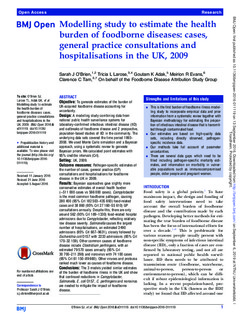| dc.contributor.author | O'Brien, Sarah J | |
| dc.contributor.author | Larose, Tricia L | |
| dc.contributor.author | Adak, Goutam K | |
| dc.contributor.author | Evans, Meirion R | |
| dc.contributor.author | Tam, Clarence C | |
| dc.date.accessioned | 2019-09-09T05:53:54Z | |
| dc.date.available | 2019-09-09T05:53:54Z | |
| dc.date.created | 2016-12-14T12:56:42Z | |
| dc.date.issued | 2016 | |
| dc.identifier.citation | BMJ Open. 2016, 6 (9), . | nb_NO |
| dc.identifier.issn | 2044-6055 | |
| dc.identifier.uri | http://hdl.handle.net/11250/2613831 | |
| dc.description.abstract | Objective To generate estimates of the burden of UK-acquired foodborne disease accounting for uncertainty.
Design A modelling study combining data from national public health surveillance systems for laboratory-confirmed infectious intestinal disease (IID) and outbreaks of foodborne disease and 2 prospective, population-based studies of IID in the community. The underlying data sets covered the time period 1993–2008. We used Monte Carlo simulation and a Bayesian approach, using a systematic review to generate Bayesian priors. We calculated point estimates with 95% credible intervals (CrI).
Setting UK, 2009.
Outcome measures Pathogen-specific estimates of the number of cases, general practice (GP) consultations and hospitalisations for foodborne disease in the UK in 2009.
Results Bayesian approaches gave slightly more conservative estimates of overall health burden (∼511 000 cases vs 566 000 cases). Campylobacter is the most common foodborne pathogen, causing 280 400 (95% CrI 182 503–435 693) food-related cases and 38 860 (95% CrI 27 160–55 610) GP consultations annually. Despite this, there are only around 562 (95% CrI 189–1330) food-related hospital admissions due to Campylobacter, reflecting relatively low disease severity. Salmonella causes the largest number of hospitalisations, an estimated 2490 admissions (95% CrI 607–9631), closely followed by Escherichia coli O157 with 2233 admissions (95% CrI 170–32 159). Other common causes of foodborne disease include Clostridium perfringens, with an estimated 79 570 cases annually (95% CrI 30 700–211 298) and norovirus with 74 100 cases (95% CrI 61 150–89 660). Other viruses and protozoa ranked much lower as causes of foodborne disease.
Conclusions The 3 models yielded similar estimates of the burden of foodborne illness in the UK and show that continued reductions in Campylobacter, Salmonella, E. coli O157, C. perfringens and norovirus are needed to mitigate the impact of foodborne disease. | nb_NO |
| dc.language.iso | eng | nb_NO |
| dc.publisher | BMJ Publishing Group | nb_NO |
| dc.relation.uri | http://bmjopen.bmj.com/content/6/9/e011119.full.pdf+html | |
| dc.rights | Navngivelse 4.0 Internasjonal | * |
| dc.rights.uri | http://creativecommons.org/licenses/by/4.0/deed.no | * |
| dc.title | Modelling study to estimate the health burden of foodborne diseases: Cases, general practice consultations and hospitalisations in the UK, 2009 | nb_NO |
| dc.type | Journal article | nb_NO |
| dc.type | Peer reviewed | nb_NO |
| dc.description.version | publishedVersion | nb_NO |
| dc.source.pagenumber | 12 | nb_NO |
| dc.source.volume | 6 | nb_NO |
| dc.source.journal | BMJ Open | nb_NO |
| dc.source.issue | 9 | nb_NO |
| dc.identifier.doi | 10.1136/bmjopen-2016-011119 | |
| dc.identifier.cristin | 1412677 | |
| dc.description.localcode | This is an Open Access article distributed in accordance with the terms of the Creative Commons Attribution (CC BY 4.0) license | nb_NO |
| cristin.unitcode | 194,65,20,0 | |
| cristin.unitname | Institutt for samfunnsmedisin og sykepleie | |
| cristin.ispublished | true | |
| cristin.fulltext | original | |
| cristin.qualitycode | 1 | |

